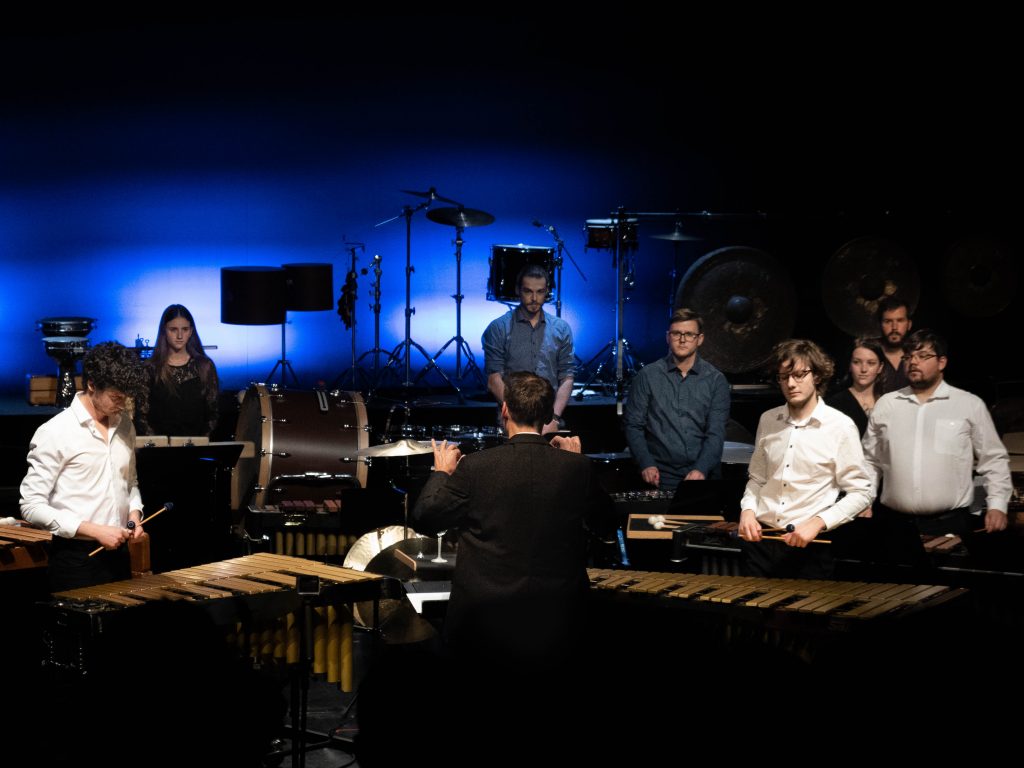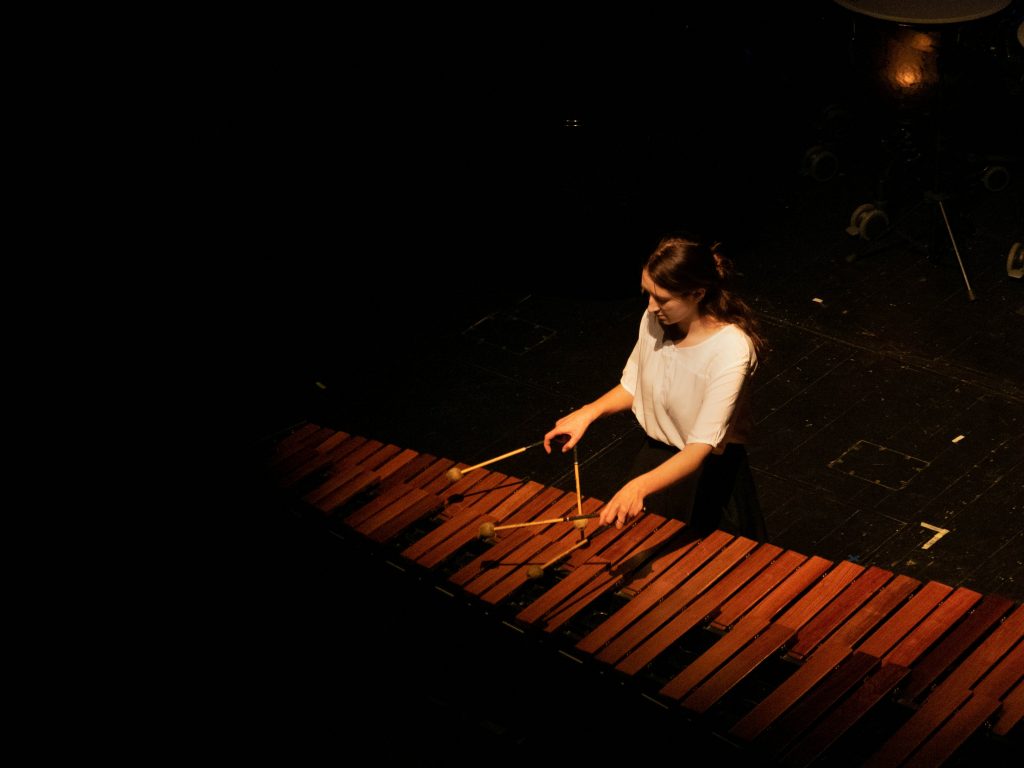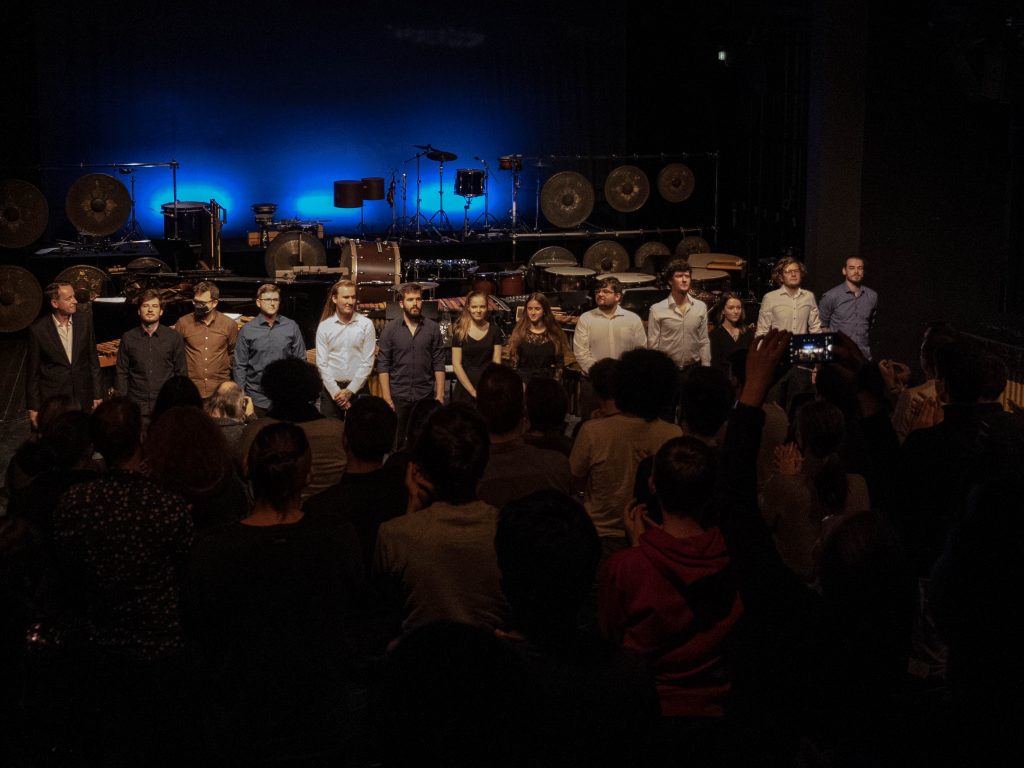Welcome to the website of the Percussion Department.
Although the department offers a single field of study, students will encounter more instruments during their studies than in any of the other fields offered by the JAMU Faculty of Music. Percussion has been taught at JAMU since 1983; it was the first university to offer such studies in Czechoslovakia. At present, the department has five university-educated teachers who help students in their professional and artistic growth. Our instrumental equipment is also unmatched on the Central European scale and provides excellent conditions for purposeful work. Come on in…

Percussion instruments department
prof. MgA. Martin Opršál - head of department
- prof. MgA. Martin Opršál , professor
- MgA. Dominik Gál , Ph.D. , Odborný asistent
- MgA. Martin Kleibl , MA, Ph.D. , assistant professor
- Kamil Slezák , assistant professor
- MgA. Radek Tomášek , assistant professor
History of the Department
Education in the field of percussion has started at the Janáček Academy of Music and Performing Arts in the academic year 1983/1984; it was the first university in Czechoslovakia to offer such studies. The introduction of this field was initially a kind of a hollow cry, because there was nowhere to teach, no instruments to use and no materials to read. In the surrounding countries and around the world, this field has long been part of teaching at art colleges.
From the beginning, the field was included under the Department of Wind, or Wind and Percussion Instruments. Antonín Paseka, a former tympanist of the Brno State Philharmonic and a long-term teacher at the Brno Conservatory, took over the teaching as an external educator. It was him who provided the place and the instruments. He taught in temporary conditions at the Brno Conservatory and this lasted until the Velvet Revolution.
In 1990, several changes took place. The first instruments were purchased – 4 Ludwig timpani, vibraphone, xylophone and a Kelon Marimba, all from the Musser brand. The classes moved to the building of the newly established JAMU Faculty of Music on Comenius Square. After Mr. Paseka, František Vlk and Pavel Šumpík, both tympanists of the Brno State Philharmonic at the time, took to the positions of external educators. Mr. Vlk taught the timpani and small drum, Mr. Šumpík taught the percussion and melodic instruments. If necessary, they borrowed the instruments from the Philharmonic across the street. Doc. Olga Petrová was the piano répétiteur from the very beginning. In the first half of the 1990s, most of the first members of the Central European Percussion Ensemble DAMA DAMA studied in one class. The first foreign contacts were established through visiting teachers and soloists.

In 1995, František Vlk left the position of assistant professor and Martin Opršál, then a member of the Brno State Philharmonic Orchestra, took his place as an external educator in the autumn of 1996. The competencies of teachers were newly divided as well. Pavel Šumpík kept teaching percussion and took over the timpani and orchestral instruments from Mr. Vlk. Martin Opršál taught melodic and chamber music. Šárka Králová became the piano répétiteur in 1994. The second half of the 1990s marked the period of gradually equipping the class with high-quality percussion instruments. Students from Slovakia, which remained one of the last countries in Europe where percussion could not be studied at university, started studying here. The spatial arrangement was temporarily stabilised. The Department acquired a training room on the third floor and classroom 06 on the ground floor served as the main room.
In 1999, Pavel Šumpík became the first docent of percussion in the Czech Republic. After the year 2000, new instruments were purchased almost annually. The originally four-year master’s degree studies were gradually replaced by a three-year bachelor’s degree studies and a two-year follow-up master’s degree studies, with the possibility of further doctoral studies. In 2007, Dalibor Němec became the first graduate of the highest achievable degree in this field in our country, i.e. a Ph.D. in percussion instruments.
In 2003, an independent Percussion Department has been established at the instigation of the then Dean of the Faculty of Music, prof. Medek. The first head of the department was Martin Opršál, a professional assistant, later a docent and since 2016 a professor. The Department enjoyed high participation in individual academic years, with as much as 10 student, the most in history. The department still kept its two rooms. With the growing quality of instrumental and music equipment, the lack of space for teaching and practice became a long-term problem.
In the autumn of 2007, doc. Pavel Šumpík died. Kamil Slezák, a member of the Moravian Philharmonic in Olomouc, and Radek Tomášek, a member of the Brno Philharmonic, had already previously collaborated externally with the department. These gentlemen and Dan Dlouhý, the head of the Central European percussion ensemble DAMA DAMA, passed the competition for the positions of professional assistants in 2008.

In 2010, a Percussion Festival was established on the initiative of Kamila Pětrašová, a student of music management. Since then, the department has held this Biennial International Percussion every even year. Beginning with its fourth iteration (2016), the festival found its home at the Theatre on Orlí Street.
After several years of efforts, in 2013 the spatial arrangement was definitively resolved, as the department completely moved to the reconstructed and newly built premises in the basement of the Faculty of Music. The Vaulted Hall is a gem of the Department – in addition to teaching and training activities, it can also accommodate smaller concerts.
In 2017, after an audition, Martin Kleibl, a graduate of doctoral studies, joined the Department’s teaching staff. The last change in the staff occurred in 2018, when doc. Šárka Králová was replaced as the piano répétiteur by doctoral student Dominik Gál.
Currently, the competencies at the department are as follows: prof. Opršál – melodic instruments, chamber music; prof. as. Slezák – small drum; MgA. Tomášek – timpani, orchestral instruments, theoretical subjects; doc. Dlouhý, Ph.D. – multipercussion, theoretical subjects; MgA. Kleibl, Ph.D. – jazz drum kit, theoretical subjects; MgA. Gál – study of the piano repertoire.
Department instrumentation
Melodic and chromatically tuned instruments
- Marimba One 3100, 5 Octave (C-c4)
- Marimba Adams Robert van Sice MAHV50, 5 Octave (C-c4)
- Marimba Musser Symphonic Grand kelon, 4½ Octave (F-c4)
- Vibrafon Yamaha YV 3710, 3 Octave (f-f3)
- Vibrafon Saito VS-4000, 4 Octave (c-c4)
- Xylofon Yamaha table YX 230, 3 Octave (c2-c5)
- Xylofon Adams Concert quint XC1HV40, 4 Octave (c1-c5)
- Studio 49 RGP Glockenspiel, 2¾ Octave (g2-e5)
- Musser M645 Classic Bells, 2½ Octave (f2-c5)
- Yamaha CH-500 Tube Chimes, 1½ Octave (c1-g2)
- Paiste CR0 1002 Pedal Cymbals, 2 Octave (c3-c5)
- Kolberg CB Tuned Cowbells, 1 Octave (c1-c2)
- Thai gongs, 3 Octave (c-c3)
- Steel pans original Trinidad (7 pieces – low tenor, double second, quattro cello)
Metal instruments
- 3 Wuhan Tam Tam (ø 60, 75, 85 cm)
- 7 Chinese opera (glisando-) gongs
- 6 Asian Sound Dobachi resting bells
- 7 Wuhan cymbals (ø 12, 14, 16, 18, 20, 22, 24´)
- 8 Paiste 2002 cymbals (ø 12´ Splash, 14´ pair Hihat, 14´ Crash, 16´ Crash, 18´ Crash, 20´ Ride, 20´ Novo China)
- 2 Paiste Alpha cymbals (ø 14´ Crash, 16´ Crash)
- 6 Zildjian K cymbals (ø 10´ Splash, 14´ Pair Hihat, 14´ Crash, 18´ Rock Crash, 22´ Ride)
- Zildjian Symphonic Viennese orchestral cymbals (pair ø 18´)
- Zildjian Classic Orchestral Selection orchestral cymbals – medium light (pair ø 20´)
- 7 Kolberg 2110S, 2117EN, 2121CCC triangles
- 5 Kolberg 1300 cowbells
- 5 Dama Percussion cowbells
- Mambo Cowbell LP229
- Cha-cha Cowbell LP ES-2
- Agogo Bell LP231A
- Kolberg 1308 finger cymbals
Membranophones
- 5 Adams Philharmonic Light timpani (Dresden)
- 4 Ludwig Professional timpani
- 4 Yamaha TP 3100 transport timpani
- Concert big drum Adams BDV32 (ø 32´)
- Concert big drum Lefima BD238 (ø 28´)
- Premier drum kit (b.d., s.d., 3x tomtom, hardware)
- Yamaha drum kit (b.d., s.d., 2x tomtom, floortom, hardware)
- Small drum Black Swamp multisonic snare (ø 14 ‘)
- 5 small Premier drums
- Small Pearl drum (ø 14‘)
- 6 Kolberg 510-516 tomtoms (ø 10, 12, 13, 14, 15, 16´)
- 3 Kolberg 506/508/510 bongs (ø 6, 8, 10´)
- 2 pairs of Meinl FWB 400NT bongs
- 3 pairs of Meinl FWB 200NT-M bongs
- 4 Meinl Floatune (ø 10, 11, 12, 13´) conga drums
- 1 pair of Meinl Marathon timbales
- 3 Asian Sound DKP-NE (ø 8, 10, 12´) metal Darabukka
- 4 Kolberg ASOD Asian barrel drums (ø 8, 9, 10, 12´)
- 5 Kolberg 1265 boobams
- 5 Remo rototoms (ø 6, 8, 10, 12, 14´)
- 3 Schlagwerk frame drums
- 3 Cooperman ethnic hand drums (bodhrán, tar, bendir)
- Daf Majid Drums (ø 20‘)
- Riq Gawharet El Fan
Wooden instruments
- 4 Asian Sound W-B woodblocks
- 5 giant Kolberg 1470 5XL woodblocks
- 5 Kolberg 2050CH temple blocks
- Original hand castanets (3 pairs)
- Studio 49 RCA4 concert castanets
- Studio 49 RP1 whip
- 2 Schlagwerk (F pentatonika) logdrums
- 4 Kolberg 512-515H wooden tomtoms (ø 12, 13, 14, 15´)
- 6 pairs of Kolberg 1289, 1283R claves
Rattles and others
- Kolberg 2030DW concert tambourine (ø 12´)
- Black Swamp concert tambourine (ø 10‘)
- 4 Stagg tambourines (ø 6´)
- Stagg Tambourine (ø 10´)
- Meinl TMT 1B-BK membraneless tambourine
- LP174 membraneless tambourine
- LP150 membraneless tambourine
- Tamburello AG Percussioni (ø 16‘)
- Brazilian Wood Pandeiro LP (ø 10‘)
- 3 LP jamblocks (1204, 1205, 1207)
- Metal chimes
- Kolberg 1385 glass chimes
- Kolberg 1213 bamboo chimes
- Flexaton
- 3 pairs of maracas
- Vibra-slap LP 209
- Cuica Contemporanea
- 3 cabasas
- Kolberg 1862 Chocallo
- 3 combinable shakers LP441T (-S, -M, -L)
- Kolberg 1122 Shekere
- 3 Kolberg 1452, 1457, 1459 güira
- Merengue Guiro LP305
- 2 angklungs
- Kolberg 1375 geophone
- Kolbeg 1729 rakatak
- Devil Chase
- Kolberg 1261 bones
- Kolberg 1253T binsasara
- Kolberg 1901 sistrum
- Water drum
- Kolberg 2271G lotus flute
- Kolberg 2297 siren
- Kolberg 1894 electric siren
- Schlagwerk marimbula
- Treble amplified Paul Tracey mbira
- Roland V-Drums electronic drum kit
Stands
- Kolberg modular system
Foreign teachers at the Department
- Roland Auzet (1990)
- Klaus Tresselt (1993, 2005)
no images were found
- Nick Petrella (1996)
- Rainer Dörer (1996)
- Nebojša Jovan Živković (1999, 2010)
no images were found
- Jeff Beer (2004)
- Nippy Noya (2005)
no images were found
- Marta Klimasara (2006)
- Peter Sadlo (2006)
no images were found
- Ignazio Berroa (2006)
- Stanislaw Skoczyński (2007)
- Roman Kozák (2008)
- Christian Dierstein (2008)
- Zoltán Rácz (2008)
no images were found
- Friedrich Ozmec (2008)
- Lenny White (2008)
- Dan Weiss (2008)
- Štefan Bugala (2009)
- Rez Abbasi (2009)
- Katarzyna Myćka (2009)
no images were found
- László Hudacsek (2009, 2010)
no images were found
- Chris Cutler (2009)
- Karol Szymanowski (2009)
no images were found
- Bogdan Bácanu (2010)
- Daniel Šoltis (2010)
no images were found
- Benjamin Toth (2010)
no images were found
- Fredrik Gille (2011)
- Glen Velez (2011)
- David Friedman (2011)
- Hakim Ludin (2011)
- Markus Leoson (2012)
- Marek Stefula (2014, 2015)
no images were found
- Marta Klimasara (2014)
no images were found
- Massimo Pastore (2014)
- Rune Martinsen (2015)
no images were found
- Mark Ford (2016, 2018)
no images were found
- Paul Rennick (2016)
no images were found
- Ed Soph (2016)
no images were found
- Ludovica Mosca (2017)
- Max Riefer (2017)
no images were found
- Uday Deshpande (2018)
no images were found
- Dom Famularo (2018)
no images were found
- Emmanuel Séjourné (2018)
no images were found
- Arend Weitzel (2019)
no images were found
Percussion ensemble JAMU
 |
It would be difficult to trace when we as humans started hitting percussion instruments in an ensemble (ensemble, troupe, group – whatever you call it). From the fact that percussion instruments are, in addition to the human voice, the oldest musical instruments on Earth, it logically follows that long ago in the depths of history, primitive objects and their “players” could group into larger units. We can recall African drummers, Central American marimbula players, Indonesian gamelan, or Basel drummers – just a few of these examples can serve as an incomplete proof of the dense roots of the chamber music phenomenon called the Percussion Ensemble. In a sophisticated and institutionalised form, this type of ensemble was stabilised during the 20th century, in connection with the worldwide boom of percussion in all areas. The development started with the first attempts to include a solo passage of the percussion ensemble in an otherwise orchestrally notated composition (E. Schulhoff: New Style Suite – 1921, A. Tcherepnin: Symphony No 1 – 1927, D. Shostakovich: opera The Nose – 1928), through the first independent opuses of the 1930s (A. Roldán: Rítmica Nos 5 and 6 – 1930, E. Varèse: Ionization – 1931, as well as H. Cowell, W. Russell and J. Beyer) and the early 1940s (C. Chávez: Toccata – 1942, several titles by J. Cage, L. Harrison), up to large compositions of the second half of the 20th century (e.g. I. Xenakis, K. Stockhausen, A. Jolivet, M. Kabeláč, W. Rihm, A. Myoshi, S. Reich, M. Kagel, T. Takemitsu). The turning point was the year 1962, when the still active ensemble Les Percussions de Strasbourg was formed. Thanks to this ensemble, but also to other subsequently emerging professional ensembles (Kroumata, Nexus, Amadinda, etc., or the Czech DAMA DAMA), numerous literature for the Percussion Ensemble was created. Unlike the numerically stable chamber ensembles – string quartet, wind quintet, piano trio – with a precisely fitting repertoire, the literature for the Percusssion Ensemble is not limited by the number of players. This is especially beneficial in a school environment where the number of students tend to vary. In 1950, percussion ensemble was first accepted in curricula at American universities. Since then, it has become customary for each university percussion class to have its own student ensemble, which is a kind of its showcase. It is no different at JAMU. Percussion Ensemble JAMU was established in 1997 and its artistic director is prof. Martin Opršál. The ensemble is used to teach chamber music at the Percussion Department of the Faculty of Music JAMU. In addition to its basic mission of educating students for detailed work in a small ensemble, the course also serves to rehearse compositions for concert performances at and outside the faculty. The ensemble has proven its quality at a number of individual performances and festivals at home and abroad. It performed Czech premieres of key compositions of its repertoire – e.g. Ionisation by Edgard Varès (2010!) or Music for 18 Musicians by Steve Reich (2003). During its existence, many established players were once part of the ensemble: Peter Kosorín – Slovak Philharmonic; Lukáš Krejčí, Radek Tomášek, Petr Hladík – Brno Philharmonic; Martin Kleibl – JAMU Brno; Dalibor Němec – Prague State Opera; Tomáš Rolek, Kristýna Karchová, Gabriel Chila – National Theatre Brno; Tereza Nosková, Bohdan Šebestík, Zuzana Mečárová, Miroslav Greman – teachers at Czech and Slovak conservatories; Štefan Bugala, Jitka Roudnická, Emil Machain, Jakub Tengler, Stanislav Pliska, Ján Fiala. This list confirms that the composition of the ensemble is not permanent, but rather constantly changing as the student change every year. Therefore, the repertoire is changing and developing as well. Selection from the ensemble’s performance outside the faculty Exhibition of New Music Brno 2001 (stará Vaňkovka Gallery) Young Podium Karlovy Vary 2002 (Art Gallery) Marathon Prague 2002 (Ponec Theatre) Concentus Moraviae 2003 (Mikulov) Sommersprossen Rotweil 2004 (Germany) Exhibition of New Music Brno 2005 (House of Arts) Percussion Summit Banská Bystrica, Liptovský Mikuláš 2007 (Slovakia) Exhibition of New Music Brno 2010 (Besední dům) Opening performance at the Theatre on Orlí Street 2012 Médeia Project 2014 (Theatre on Orlí Street) International Music Festival Janáček Brno 2014 (FoM JAMU) Carl Orff: Die Kluge (version with 2 pianos and percussion ensemble) 2017 (Theatre on Orlí Street) Young Blood 2019, 2020 (Brno Philharmonic cycle) |